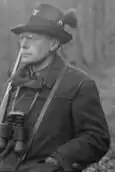Walter von Keudell | |
|---|---|
 | |
| Reich Minister of the Interior | |
| In office 31 January 1927 – 12 June 1928 | |
| Chancellor | Wilhelm Marx |
| Preceded by | Wilhelm Külz |
| Succeeded by | Carl Severing |
| Member of the Reichstag | |
| In office 27 May 1924 – 18 July 1930 | |
| Constituency | Frankfurt (Oder) |
| Personal details | |
| Born | 17 July 1884 Castellamare di Stabia, Naples, Kingdom of Italy |
| Died | 7 May 1973 (aged 88) Bonn, West Germany |
| Nationality | German |
| Political party | Christian Democratic Union of Germany (1948-1973) |
| Other political affiliations | |
Walter von Keudell (17 July 1884 – 7 May 1973) was a German forest expert and politician. He served as interior minister of Germany between 1927 and 1928 during the period of the Weimar Republic.
Early life
Von Keudell was born in Castellamare di Stabia, Naples, Italy, on 17 July 1884.[1] He was the oldest son of Robert von Keudell, German diplomat and a member of the Reichstag.[1] His mother was Alexandra von Grünhof. He had a brother, Otto von Keudell, and a sister, Hedwig von Keudell.
Career
Von Keudell started his career in the forest administration in Frankfurt/Oder in 1908. From 1915 he worked at the Reichsgetreidestelle (Reich grain administration). From 1916 to 1920 von Keudell was Landrat at Königsberg (Neumark) (today Chojna). As a result of the failed Kapp Putsch, which he supported, von Keudell had to retire and worked as a farmer at Gut Hohenlübbichow.[2]
However, he returned to politics and was elected as a member of the Reichstag for the German National People's Party (DNVP) from 1924 to 1930 (after 1929 Christian-National Peasants' and Farmers' Party).[2][3]
On 31 January 1927 von Keudell was appointed Reichsinnenminister (minister of the interior) and vice chancellor in the fourth cabinet of chancellor Wilhelm Marx.[3][4][5] He was one of three nationalist cabinet members.[6][7] The cabinet resigned on 12 June 1928 and Carl Severing replaced von Keudell as interior minister on 29 June 1928 when the new government headed by Hermann Müller took office.[8]
Shortly after the Nazi seizure of power, von Keudell joined the Nazi Party on 1 March 1933, and on 8 August he was appointed Prussian Oberlandforstmeister and head of the Prussian Landesforstverwaltung (State Forest Administration) in Brandenburg.[9][2][10]
On 3 July 1934, Reichsforstmeister Hermann Göring appointed von Keudell as Generalforstmeister in the newly established Reichsforstamt (Reich Forestry Office) and, on 1 March 1935, appointed him to the Prussian State Council.[9] On 1 May 1936, Göring promoted him to Staatssekretär (State Secretary) and made him his permanent deputy (ständiger Vertreter des Reichsforstmeisters).[9] In 1937 von Keudell also became a member of the Reichsverkehrsrat (Reich transportation council).[2][11][12] Von Keudell was removed from office on 1 November 1937 (im einstweiligen Ruhestand) when he refused to implement the forest policy of Göring which advocated the use of the mandatory cutting quota in private forests as in public forests.[12] Friedrich Alpers succeeded von Keudell in the post.[12][2]
In 1948, von Keudell joined the Christian Democratic Union.[2]
Personal life and death
Walter von Keudell was a devout Protestant.[13] He died in Bonn on 7 May 1973.[1]
References
- 1 2 3 "Walter von Keudell". Munzinger. 16 July 1973. Retrieved 17 October 2013.
- 1 2 3 4 5 6 "Keudell, Walter von". Bundesarchiv. Retrieved 17 October 2013.
- 1 2 Hermann Beck (2011). The Fateful Alliance: German Conservatives and Nazis in 1933: The Machtergreifung in a New Light. Berghahn Books. p. 56. ISBN 978-0-85745-410-2.
- ↑ Eastern, Northern and Central Europe. Annex: International Organisations. Walter de Gruyter. 2006. p. 785. ISBN 978-3-11-093910-1.
- ↑ Harry C. Carman (1 March 1927). "Germany's New Coalition Ministry". Current History. 25 (6): 887. doi:10.1525/curh.1927.25.6.887. S2CID 248843654.
- ↑ Ellen L. Evans (June 1969). "The Center Wages Kulturpolitik: Conflict in the Marx-Keudell Cabinet of 1927". Central European History. 2 (2): 148. doi:10.1017/S0008938900000170. JSTOR 4545524. S2CID 145666646.
- ↑ Ellen Lovell Evans (1981). The German Center Party, 1870-1933: A Study in Political Catholicism. Carbondale, IL: Southern Illinois University Press. ISBN 978-0-8093-0997-9.
- ↑ Walter H. Kaufmann (1953). Monarchism in the Weimar Republic. New York: Bookman Associates. ISBN 9780374945275.
- 1 2 3 Joachim Lilla (2005). Der Prußische Staatsrat 1921–1933: Ein biographisches Handbuch (in German). Düsseldorf: Droste Verlag. pp. 213, 297. ISBN 978-3-770-05271-4.
- ↑ RüdigerBergien (2012). Die bellizistische Republik (in German). Munich: Oldenbourg Verlag. p. 367. doi:10.1524/9783486705492. ISBN 978-3-486-59181-1.
- ↑ Franz-Josef Brüggemeier; Mark Cioc; Thomas Zeller (2005). How Green Were the Nazis?: Nature, Environment, and Nation in the Third Reich. Ohio University Press. p. 31. ISBN 978-0-8214-1647-1.
- 1 2 3 Thomas Lekan; Thomas Zeller (2005). "Introduction: The Landscape of German Environmental History". In Thomas Lekan; Thomas Zeller (eds.). Germany's Nature: Cultural Landscapes and Environmental History. New Brunswick, NJ: Rutgers University Press. ISBN 978-0-8135-3770-2. JSTOR j.ctt5hj2sz.
- ↑ Noel D. Cary (1996). The Path to Christian Democracy: German Catholics and the Party System from Windthorst to Adenauer. Cambridge, MA: Harvard University Press. ISBN 978-0674657830.
External links
- Newspaper clippings about Walter von Keudell in the 20th Century Press Archives of the ZBW
- Information about Walter von Keudell in the Reichstag database